I had the day off today so went down to the apiary to take a look in the hives, as several days of rain plus work have meant there haven’t been many chances for Emma and me to inspect. Today was the first chance since starting the Bailey exchange two weeks ago.
As I opened Rosemary’s hive, I was expecting her drone laying to have got progressively worse, and to possibly find a supersedure cell as a result. Sadly I found something worse – brood disease. I’m not sure what type of disease yet. Hopefully maybe John or Andy or someone else more experienced can have a look at the weekend, and see if we need to call in Caroline, our local bee inspector.
I didn’t see Rosemary or eggs, but I did see uncapped larvae – but it didn’t look healthy. Some of the larvae looked dried and crusty. Some of them looked bloated, twisted and lacking in the segmented definition of a healthy larvae. There were some perforations in the wax cappings – a bad sign as it means the workers have recognised a diseased larvae and are trying to remove it. Some people online have suggested chalk brood, but it doesn’t all look like the photos of chalkbrood to me. What do you guys think?
These bees are usually so calm that we hardly bother smoking them, but today I smoked them a few times. They were irritable. They have no healthy brood, and possibly no queen – certainly not a worker-laying queen. There was a thin film of honey over some of the stored pollen, something Ted Hooper mentions in his Guide to Bees and Honey as a possible sign of queenlessness, as the honey preserves the un-needed pollen from going mouldy. The workers returning to the hive were not bringing pollen in.
Seeing the diseased brood reminded me of how inexperienced I am. It seemed to have a whole mix of different problems, not like the photos I’ve seen illustrating one particular issue. Books help give a background to what you do, but they’re not a substitute for having seen this sort of thing before with your own eyes and hives.
Hopefully John or Andy or someone else who knows what they’re doing can take a look this weekend and see if we need to call Caroline, our local bee inspector, in. We will need to call her if European or American Foul Brood is suspected. I am worried that it may be EFB as the brood looks a bit similar to the EFB photos in the FERA ‘Foul Brood Disease of Honey Bees‘ leaflet. It is an E-arly brood infection, killing larvae before they’re sealed in their cells. The culprit is a mass of bacteria inside the gut of an infected larvae, which can cause death from starvation. The brood pattern will often appear patchy and erratic as dead brood is removed by the bees. When an uncapped larvae dies it lies in an unnatural attitude suggesting pain – twisted spirally around the walls, across the mouth of the cell or stretched out lengthways. The remains may dry to form scales, which are variable in colour, loose and somewhat ‘rubbery’, unlike the hard black scales of AFB. I hope I’m wrong and it is just chalk brood as EFB is nasty stuff.
After inspecting Rosemary’s hive I changed my gloves and hive tool before looking in Lavender’s in case I transmitted infection. It was so nice to see that they at least are doing well, Lavender is laying superbly and they are getting on well with drawing out comb following the Bailey comb exchange. Tons of bright yellow, orange and even greeny pollen was being taken in.
I noticed this gorgeous object up in one of the apiary trees. I think it must be a swarm trap.
I love this view as I leave the apiary on a sunny day – blossom and rushes. Even next to a busy dual-carridge way some beautiful things can exist.

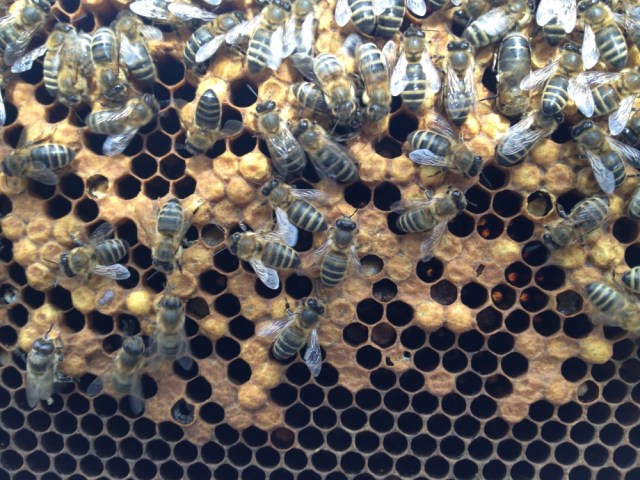
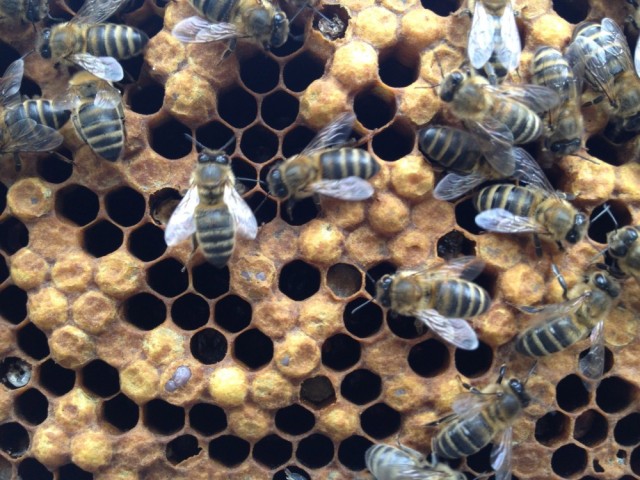
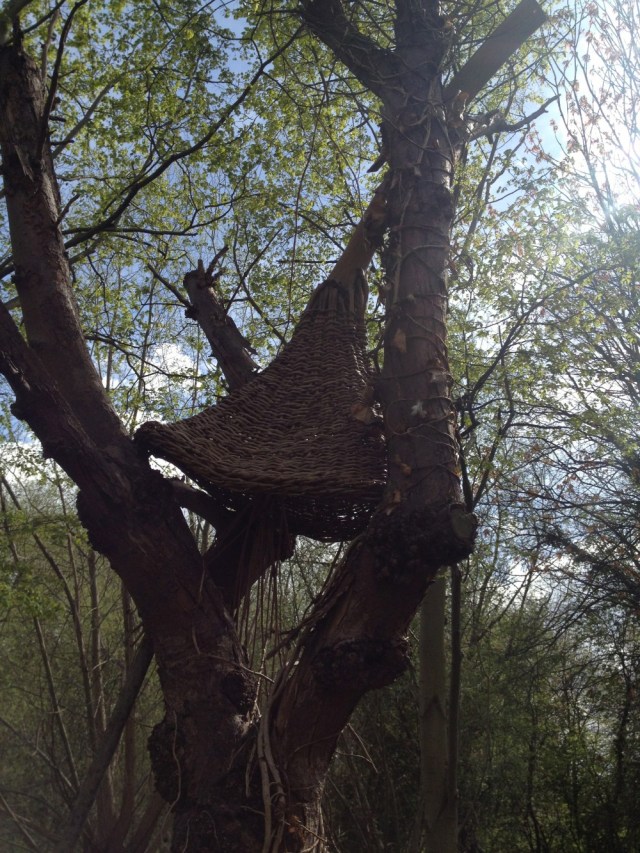
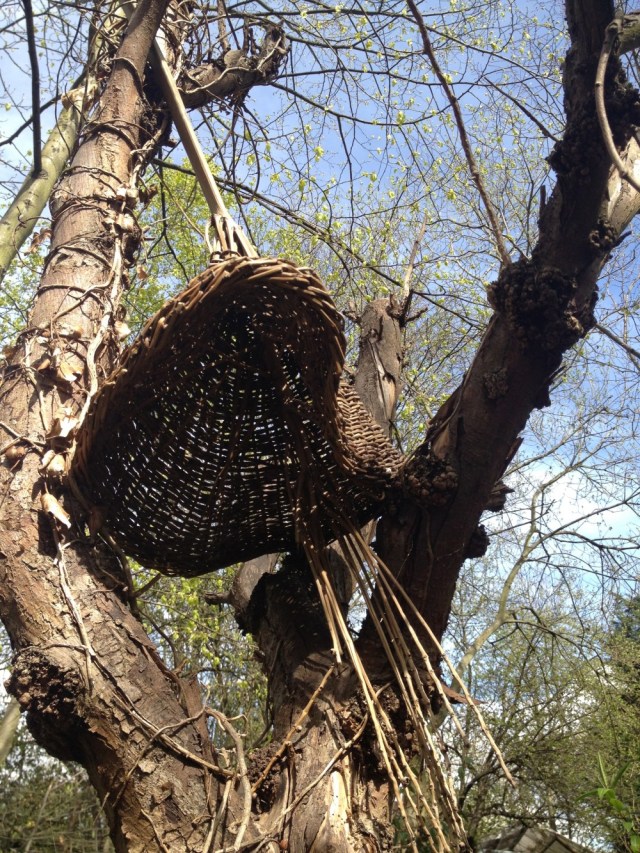
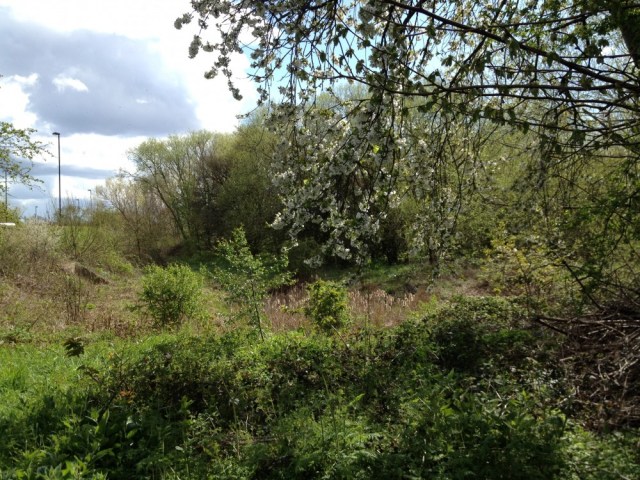
Sorry to read of trouble in the hive . . . I hope it can be resolved.
LikeLike
Thanks 🙂 I’m sure we can sort it out eventually.
LikeLike
Dip a twig into one of the cells and see if it comes out gummy. Does it smell? AFB is truly disgusting. Like rotted meat. With chalkbrood, which I had briefly last summer in a hive that had grass build-up around the entrance and too much moisture inside as a result, you can see the workers carrying out the chalky white brood.
LikeLike
Thanks Marty. It doesn’t smell at all, so that’s good. I didn’t notice any chalk mummies by the entrance but I might have missed them.
LikeLike
I would still get someone in immediately to diagnose it. AFB is insanely contagious. I just forwarded this to Chris Hart, our fabulous bee guru here in the New York area. I’ll let you know what he says.
LikeLike
One of my bee gurus said it looked like sacbrood. Still awaiting the verdict from Chris…
LikeLike
Thanks Marty for forwarding the pics! My local association’s Secretary, Andy, is having a look on Saturday. From the photos he doesn’t think it’s EFB but is bringing a lateral flow device to test with just in case.
LikeLike
I will be following this so when you find out i will know too. Does not look good.. Though i would have no idea.. It is dreadful when something takes over your lovely healthy hive.. c
LikeLike
Thanks so much Cecilia. We’ve been so lucky with them up to now. Fingers crossed that we can get them healthy again.
LikeLike
Emily, don’t mess about – get on to the Bee Inspector NOW! If you can’t say it is NOT foulbrood the only safe assumption is that it is and you have a legal duty to report it without delay. The way some of the larvae in open cells are slumped looks to me rather like EFB. The Bee Inspector would rather be called to a dozen false alarms than have cases left to spread. How close together are the hives? EFB often spreads by drifting.
LikeLike
Thanks Chris. Our local association Secretary is bringing a lateral flow kit to test them with. The nearest hive is about ten feet away but drone drifting is probably going on.
LikeLike
Sorry to hear about your bee troubles. I hope you work it out ASAP. I feel bad for your little workers.
LikeLike
Thanks, me too. I just want to get them better.
LikeLike
I’m very sorry to read about your bee troubles, too. I’ll be checking back to hear what you find out.
LikeLike
Thanks. Hopefully with Andy & John’s help we can get them sorted out.
LikeLike
I hope Rosemary’s hive is okay; it sounds ominous, but I know how easy it is to go to worst case scenario, too. I’m still worried about my hive but have yet to open it up after the winter. There don’t seem to be as many bees flying as there were just a few weeks ago. I put a syrup feeder out (a liter or so in my chick waterer) and they ignored it at first, but now I see a lot of them on it. Drained one liter so far and are halfway through the second. Lots of pollen on the girls, too, so they’re busy. I just wish there were more of them. Maybe they’re busy inside with spring hive work (brood and building comb)?
I’ll be watching for your next post. Best wishes!
LikeLike
That’s a good sign about the pollen collection. Now is a difficult time for the bees as the winter workers are dying off yet the queen is increasing her laying, so until about May (in the UK’s climate anyway) brood outnumbers the adult bees and the workers are stretched a bit thin. What’s the average April temp where you are, is it warm enough to inspect yet?
LikeLike
Our climate here is similar to the UK (Pacific NW) – we have a lot of British ex-Pats that say so (wet winters and spring, temps drop below freezing/snow only occasionally). That said, we’ve had a wet, cool late winter and spring…except for this weekend, when it got up to the mid-60s F on Saturday. But I still didn’t inspect! They seem busy, and I’m going to keep the feeder out for another week, and keep hoping. I get my new bees next weekend so was setting up the new hive in the “bee yard” today. I was so sorry to hear about Rosemary. 😦
LikeLike
I’m so sorry to hear you’ve got a sick hive. Hopefully you’ll get a firm diagnosis and be able to deal with it soon.
LikeLike
Thanks Shady. I’ll feel better once we know what we’re dealing with.
LikeLike
Oh no! I’ve got my fingers crossed for Rosemary’s hive 🙂 I start my beekeeping training on Monday so I’m finding your blog really informative & helpful.
Leanne x (http://buzzbeefbeauty.blogspot.co.uk/)
LikeLike
Thanks Leanne. Your blog is great. I read your post about struggling with the woodwork – I am so rubbish at the woodwork, trust me! But I have got a bit better and I feel confident that in about ten years time I’ll be able to knock in nearly every nail straight.
LikeLike
So sorry to hear about this. It’s all you need right now. A bee inspector diagnosed chalk brood in one of my hives last summer, and based solely on your photograph it looks similar. However, I agree with other comments that it’s probably best to get a bee inspector in, just to be on the safe side. I only had one or two cells of it, and it did clear up. My girls were cranky, but I think that was down to other factors. They are back to being the well-mannered gels they were meant to be–we were even able to mow our lawn this weekend without bee suits!
Keep us er…posted….
LikeLike
Thanks. Our local association Secretary, Andy, had a look at the photos. He doesn’t think it’s EFB from the pics but is bringing a test kit just in case. That’s great that you can mow the lawn without bee suits on – having to wear one for that would get a bit sweaty I imagine!
LikeLike
Hi Emily,
Here’s what our local bee doctor in New Paltz, NY says:
“I do see chalkbrood. I’m also about 85% sure I see EFB or AFB. The test is to put a toothpick into one of the sunken caps, if it ropes out more than 3/4 to 1″ it is AFB, Less than 1/2” it is EFB. No roping, no EFB or AFB.
I do not suspect sak brood.
I also see that the Queen (if there is one) is laying drone eggs in worker cells on occasion and the colony needs to bee re-queened or let them do a supersedure (soon).
Enjoy Peace,
Chris
HoneybeeLives.org
LikeLike
Hi Marty,
That is very kind of you to ask Chris for us, and for him to take a look. Andy is going to test for EFB on Saturday. I’m steeling myself for the worst. Will let you know what happens.
Thanks
Emily
LikeLike
Our poor bees, I know that we shouldn’t get attached but it breaks my heart to think of them being so sick.
That this has happened so fast is what shocks me. While the rain prevented a full hive inspection for the past two weekends, it is only a fortnight past that we did peer, very closely, at the brood frames (as well as John and Pat and a number of others) scrutinising almost every cell in order to find eggs inside this hive. A drone-laying queen was suspected but no brood disease. But just two weeks later and sick brood too! So unlucky!
Well done, Emily for acting on this so quickly and sending the photos to Andy immediately, which is probably as good as contacting the bee inspector given that Andy is a sentinel apiarist for the Middlesex area. I’m relieved that he has already seen these photos and will be helping us, with John, to test the hive on Saturday considering their decades of experience!
I hope it isn’t EFB and think AFB, from what I’ve read, might be unlikely as even John has only seen one case of AFB over here during all his years as a beekeeper. It is probably futile to speculate until we test the hive on Saturday, but I do wonder if the brood can look unhealthy if there are not enough workers inside the hive to look after them? We shall have to wait and see.
As a beginner beekeeper, I can really see from this why recognising bee diseases is such a crucial, and difficult, skill to learn, and why all good beekeeping courses should place an emphasis on this. Also good to be reminded by Emily why it is so important to exercise hygiene between inspecting each hive by changing gloves and tools.
I am really sad about Rosemary and her family but these are all useful and important lessons to learn as a beekeeper.
LikeLike
I was amazed at how fast it happened too. I think you’re right and the winter bees dying off and a lack of nurse bees probably hasn’t helped.
Reading my FERA foul brood leaflet, it says chalkbrood is most likely to be serious in colonies that are finding it difficult to care adequately for their brood, so is most likely to become an issue in weak colonies during early spring. Similarly it says EFB can become most obvious in late spring, because when there is a high ratio of brood to nurse bees, larvae tend to receive less brood food and so are more likely to suffer from starvation as the EFB bacteria compete for food in their gut. When there is lots of brood food available, EFB infected larvae can survive and become healthy adult bees, so we could even have had EFB in the hive last summer and not realised.
It will be good to find out for sure what’s going on this weekend. I hope we can help them.
LikeLike
Wanted to come by and see if you guys figured out what it was. I sure hope it isn’t foul brood. Sounds like it porbably isn’t, so I’ll keep my fingers crossed for our bee friends.
LikeLike
Oh dear, I hope it isn’t anything too serious. Our local beekeeping expert Randy Oliver has some interesting articles on his web site about bee diseases (and much, much more) that you might find interesting (if not too depressing!) — he has given some great talks at our beekeeping club about all these tiny, very subtle signals that something isn’t right in the hive….. I can only aspire to cultivate that kind of attention to detail!
http://scientificbeekeeping.com/colony-health/
I’d love to know more about the swarm trap, if that is indeed what it is — much prettier than the buckets we make ours from!
LikeLike
Hi Julia,
Wow, you are lucky to have Randy living near you. I’ve come across his website before and been seriously impressed by it. He must be a fascinating speaker.
Will try to find out more about the swarm trap for you! It looks beautifully made.
LikeLike
Aw, sorry to hear it! 😦 poor things
LikeLike
Thanks. It is really sad to see. Hope we can get them better again.
LikeLike
Good luck with this situation. I know it has to be heartbreaking to want to do something, but not know what to do. Keep us all posted about the results from the tests. Good luck from a fellow beekeeper in the eastern U.S.
LikeLike
Thanks Mark, that is very kind. I’ve been overwhelmed with how many nice messages people have left me here. Your blog is great by the way, I’ve signed up to read it via Google Reader.
LikeLike
I’m sorry your hive is sick, but thank you for sharing your photographs. I always find it helpful to learn from other beekeepers, both the good, and the bad. I hope you’ll let us know what is ultimately found. Personally I’m suspicious for EFB just based on the photographs. We’ve heard recent reports through our bee guild of some confirmed AFB cases locally that did NOT rope, so I pass that along for what it’s worth. Why those larvae didn’t rope, I can’t say as I didn’t see them personally (thank goodness). Just something we were told to be aware of. Of course, I hope it’s neither AFB nor EFB. Good luck!
LikeLike
Thanks. That’s interesting about the non-roping AFB cases. Luckily AFB seems to be less common here.
LikeLike
Interesting blog. Friends of mine locally (North Surrey) have recently taken up bee-keeping but their first colony has failed. They found the queen dead and most of the bees gone. I have learned from their experience what a complicated art bee-keeping is. Good luck to you,
LikeLike
Hi Rachael,
Thanks very much. Sorry to hear about your friends bees. It is not easy, especially not in this weather, which is making everything harder than usual.
LikeLike
Amazing to read and learn about the intimate lives of bees- I hope this situation got better for you! Did you hear about the 30,000 bees people found in a house in New Jersey recently? So much going on with these incredible insects!
LikeLike
Thanks 🙂 It’s hard to tell whether the situation has got better here, as we haven’t had a free day nice enough to inspect on in a month. When it’s cold and rainy we can’t look in, in case we chill the brood. April was the wettest the UK’s ever had since records began! And right now I can hear it raining, May seems like the same again. As Emma says, we need to do a sun dance!
LikeLike